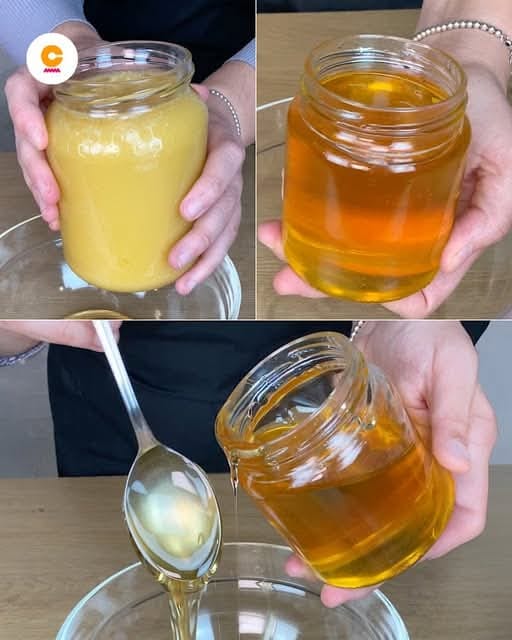ADVERTISEMENT
ends to crystallize faster when stored at cooler temperatures, typically around 50-57°F (10-14°C). If your honey is stored in a place that is too cool, you’re more likely to find it crystallized. Conversely, honey that’s kept in warmer conditions will take longer to crystallize.
For Complete Cooking STEPS Please Head On Over To Next Page Or Open button (>) and don’t forget to SHARE with your Facebook friends
3. Pollen and Impurities:
Raw honey, which hasn’t been filtered or pasteurized, contains small amounts of pollen, beeswax, and other particles. These can act as “seeds” for crystallization, causing the glucose in the honey to bind and form crystals. This is why raw or unprocessed honey tends to crystallize more quickly than highly processed honey.
4. Low Moisture Content:
Honey has a low water content, usually around 17-18%. Because of its low moisture content and high sugar content, honey is a super-saturated solution, which means it’s more likely to form crystals. Over time, if honey isn’t consumed or used, it will naturally begin to crystallize.
Is Crystallized Honey Still Safe to Eat?
Absolutely! Crystallization is a natural and harmless process. It’s simply a change in the texture and appearance of the honey, not a sign of spoilage. In fact, crystallized honey is still perfectly safe to consume and will taste just as good as liquid honey. Some people even prefer crystallized honey for spreading on toast or using in baking, as its consistency makes it easier to spread.
How to Decrystallize Honey:
If you prefer your honey in liquid form, don’t worry. There are several simple methods to reverse the crystallization and return it to its smooth, runny state. Here’s how to do it:
1. Warm Water Method (Most Effective):
This is the easiest and most effective way to decrystallize honey. Here’s how:
- Step 1: Place your jar of honey (with the lid on) in a bowl of warm water.
- Step 2: Heat the water to around 95-110°F (35-43°C), which is warm enough to dissolve the crystals but not too hot to damage the honey’s enzymes and nutrients.
- Step 3: Allow the jar to sit in the water for 10-15 minutes, occasionally stirring to help speed up the process. You’ll notice the crystals begin to dissolve back into the liquid.
- Step 4: Once the honey has returned to its original consistency, remove the jar from the water and dry it off.
Tip: Avoid using boiling water, as high heat can degrade the honey’s flavor and nutritional properties.
2. Use a Double Boiler:
If you don’t want to submerge the jar directly in water, you can use a double boiler method:
- Step 1: Fill a saucepan with a little water and place a heatproof bowl or the honey jar inside it.
- Step 2: Turn the heat on low and allow the steam from the boiling water to gently warm the jar.
- Step 3: Stir the honey occasionally to help the crystals dissolve evenly. Be patient—this process may take a little longer but will effectively restore the honey.
3. Microwave Method (Use Caution):
While it’s not the ideal method, you can use the microwave to decrystallize honey quickly:
- Step 1: Place the honey in a microwave-safe container (make sure it’s not in the glass jar if it’s not microwave-safe).
- Step 2: Heat the honey in short bursts of 20-30 seconds on medium-low heat, stirring in between each session to ensure it heats evenly.
- Step 3: Once the crystals have dissolved and the honey has returned to its liquid state, remove it from the microwave and let it cool slightly before using.
Note: Be very cautious when using this method. Microwaving honey can sometimes result in uneven heating and can cause the honey to overheat and lose some of its beneficial properties. Always monitor closely.
4. Prevent Future Crystallization:
To prevent your honey from crystallizing in the future, store it in a warm, dry place. Keep it away from the fridge or anywhere too cool, and make sure the jar is sealed tightly to prevent moisture from entering, which can accelerate crystallization.
Conclusion
Crystallized honey is a natural and harmless process that can happen to pure honey over time. It’s not an indication that the honey is bad, but rather a sign of its quality. Fortunately, decrystallizing honey is easy and can be done with minimal effort. Whether you prefer your honey liquid or enjoy the spreadable texture of crystallized honey, knowing how to restore it to its original form will help you make the most of this sweet, versatile ingredient.
